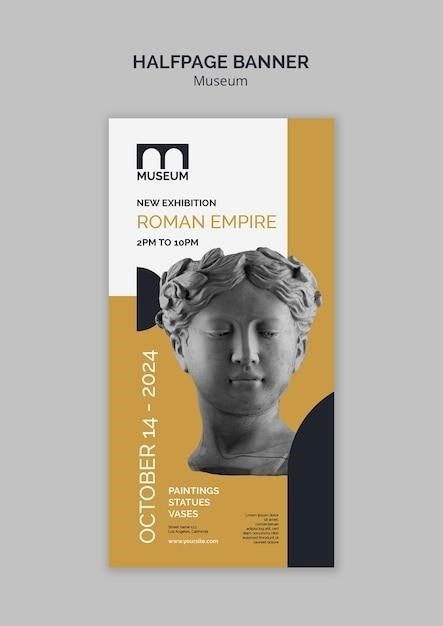Aristotle’s Categories⁚ A Comprehensive Guide
Aristotle’s Categories is a foundational work in philosophy, offering a framework for understanding the fundamental types of things that exist in the world. This text, part of his Organon, delves into the nature of being and provides a systematic analysis of the categories that govern our thinking and language. Categories has been a cornerstone of philosophical discussion for centuries, influencing generations of thinkers and shaping our understanding of logic and ontology.
Introduction⁚ The Foundation of Aristotelian Logic
Aristotle’s Categories, a cornerstone of his Organon, is a treatise that lays the foundation for his system of logic. It delves into the fundamental building blocks of thought and language, exploring the nature of being and the ways in which we categorize and understand the world around us. This work, often considered a foundational text in philosophy, provides a systematic framework for analyzing the structure of propositions and the relationships between different types of entities. Categories is a vital resource for anyone seeking to understand the development of logic and its impact on Western philosophical thought.
The text begins by defining the concept of “being said of” and “being in,” which establish the basis for understanding how predicates relate to subjects in a proposition. Aristotle then proceeds to introduce his famous ten categories, which represent the most general types of things that can be the subject or predicate of a proposition. These categories provide a comprehensive framework for classifying and understanding the diverse array of things that exist in the world.
Aristotle’s Categories is not simply a linguistic analysis; it is a philosophical exploration of the fundamental nature of reality. By examining the categories of being, Aristotle seeks to uncover the underlying structure of the world and the principles that govern our knowledge of it. This work continues to be studied and debated by philosophers and scholars, offering valuable insights into the nature of language, logic, and the very essence of being.
The Ten Categories⁚ A Framework for Understanding Being
Aristotle’s ten categories, presented in his Categories, provide a comprehensive framework for understanding the fundamental types of things that exist in the world. These categories are not simply a linguistic classification; they represent a philosophical exploration of the nature of being itself. Aristotle’s categories offer a systematic way of organizing our knowledge and understanding of the world, revealing the underlying structure of reality and how we perceive it.
The ten categories are⁚ substance, quantity, quality, relation, place, time, position, state (condition), action, and affection. These categories represent the most general ways in which we can think about and describe the world. Substance, for example, refers to the fundamental nature of a thing, while quantity refers to its measurable attributes. Quality describes its properties and attributes, while relation signifies its connections to other things. Place and time locate a thing in space and time, while position describes its physical arrangement. State, action, and affection characterize its condition, activities, and experiences.
These categories provide a systematic framework for understanding the diversity of things that exist in the world. They enable us to analyze and classify objects, concepts, and events, providing a foundation for logical reasoning and philosophical inquiry. Aristotle’s ten categories remain a significant contribution to the history of philosophy, offering a lasting framework for understanding the nature of being and the structure of reality.
Substance⁚ The Foundation of Reality
In Aristotle’s Categories, substance stands as the most fundamental category, representing the core essence of things. It is the underlying reality, the “whatness” that defines an object, making it what it is. Substance is distinct from the other categories, which are considered to be properties or attributes of substance. For instance, a statue is a substance, but its color, size, and material are qualities that describe it.
Aristotle distinguishes between primary and secondary substances. Primary substances are individual, concrete things like a specific human being or a particular horse. They are the ultimate subjects of predication, meaning that other categories can be predicated of them. Secondary substances, on the other hand, are general categories or kinds, such as “human” or “horse.” They are not individual things but rather refer to the universal nature of a group.
Substance is essential for understanding Aristotle’s philosophy. It serves as the basis for his metaphysics, ethics, and logic. His theory of substance emphasizes the importance of individual, concrete things as the foundation of reality. Substance is not merely a linguistic category but a fundamental ontological concept that shapes our understanding of the world and its constituents.
Quantity⁚ Measuring the World
Quantity, for Aristotle, is the category that encompasses the measurable aspects of things, allowing us to quantify and compare their size, number, and extent. It provides a framework for understanding the world in terms of its numerical and dimensional properties. Aristotle identifies two primary types of quantity⁚ discrete and continuous.
Discrete quantities are those that can be counted, like individual objects or units. They are distinct and separated, with clear boundaries between each unit. Examples include the number of people in a room, the amount of coins in a purse, or the number of stars in the sky. Discrete quantities are characterized by their ability to be added and subtracted in a definite way.
Continuous quantities, on the other hand, are those that can be divided into smaller parts without losing their fundamental nature. They represent a seamless flow or extension, such as the length of a line, the area of a surface, or the volume of a solid. Time is also considered a continuous quantity, as it is a seamless flow that cannot be divided into discrete units. Continuous quantities can be measured and compared, but they are not composed of separate, countable units.
Quality⁚ Describing Properties and Attributes
Aristotle’s category of Quality encompasses the essential characteristics, properties, and attributes that define a thing. It delves into the realm of description, allowing us to understand what makes one thing different from another. Quality encompasses a wide range of aspects, including both inherent features and acquired qualities.
Aristotle identifies two primary types of qualities⁚ “Habits” and “Affections”. “Habits” refer to inherent characteristics that are part of a thing’s nature. These are stable and enduring properties, such as a person’s intelligence, a rock’s hardness, or a flower’s color. In contrast, “Affections” are qualities that are acquired or temporary. These are temporary states or conditions, such as being sick, feeling happy, or being heated. While Habits are fundamental aspects of a thing, Affections are often temporary and can change over time.
Quality plays a crucial role in understanding the world around us. It allows us to differentiate between objects, categorize them, and make sense of their individual characteristics. Quality is not merely a matter of appearance or superficial traits; it delves into the essential nature of things, revealing what makes them unique and distinct;

Relation⁚ Connecting Things in the World
Aristotle’s category of Relation explores the intricate web of connections that exist between things in the world. It goes beyond simply describing individual objects and delves into the nature of their relationships, revealing how they interact and influence each other. Relation is not merely a matter of spatial proximity or causal connection; it encompasses a wide range of interconnectedness, including kinship, possession, knowledge, and more.
Aristotle distinguishes between different types of relations, including relative terms, such as “double” or “half,” which express a relationship of quantity. He also identifies relationships of position, such as “before” or “after,” and relationships of knowledge, such as “knowing” or “being known.” These different types of relations illustrate the diverse ways in which things are interconnected and the importance of understanding these connections for comprehending the world.
The category of Relation highlights the interconnectedness of reality, emphasizing that things do not exist in isolation but are part of a larger web of relationships. This concept underscores the dynamic and interactive nature of existence, where things are constantly influencing and being influenced by one another. Understanding relations is essential for comprehending the complex tapestry of our world and the intricate connections that bind us together.
Place⁚ Locating Things in Space
Aristotle’s category of Place addresses the fundamental question of where things are located in the physical world. It explores the concept of spatial location, not merely as a point on a map but as an inherent property of objects, defining their relationship to the surrounding environment. Place, for Aristotle, is more than just a container; it actively contributes to the existence and nature of the things it contains.
He argues that a thing’s place is its immediate surroundings, the space it occupies, and the boundaries that define its location. This concept is crucial for understanding the physical world, allowing us to differentiate between objects and their positions. Place is not just a static concept, but a dynamic one, as objects can move within space, changing their relationship to their surrounding environment.
Aristotle’s analysis of Place also touches upon the concept of relative location, where the position of an object is defined by its relationship to other objects. For instance, a house is located “next to the river” or “across from the market,” illustrating how objects are defined by their spatial proximity to other things. Understanding Place is essential for comprehending the spatial structure of the world and the relationships between objects within it.
Time⁚ Situating Things in Time
Within Aristotle’s framework of categories, Time stands as a fundamental element for understanding the temporal dimension of existence. It transcends mere measurement, delving into the nature of time itself and how it shapes our understanding of events, processes, and the very essence of being. Time, for Aristotle, is not merely a sequence of moments but a continuous and indivisible flow. It is a measure of change and movement, a crucial aspect of the world that cannot be separated from the things it contains.
He distinguishes between past, present, and future, recognizing that these are not discrete points in time but rather perspectives on a continuous flow. The past is what has already occurred, the present is the moment of experience, and the future is what is yet to come. This understanding of time is crucial for understanding the sequence of events and the causality that binds them together; Time, for Aristotle, is not merely a backdrop but an active participant in the unfolding of reality.
Aristotle also examines the relationship between time and motion, recognizing that time is measured by change and movement. The passage of time can be observed through the changing positions of objects, the growth of plants, or the decay of matter. Time, for Aristotle, is not merely a static concept but a dynamic one, inextricably linked to the processes of the world. His exploration of Time within his categories provides a framework for comprehending the temporal dimension of existence and its influence on our perception of reality.
Position⁚ Describing Physical Arrangement
Aristotle’s category of Position delves into the spatial arrangement of things, exploring how objects relate to each other in terms of their placement and orientation. It goes beyond simply stating where something is located, examining the relative positions of objects within a given space. This category allows for a nuanced understanding of how objects occupy space and interact with their surroundings.
Aristotle recognizes that Position is not merely a static description but a dynamic one, subject to change as objects move within a space. He examines concepts such as “above,” “below,” “before,” and “behind,” recognizing that these spatial relationships are relative and dependent on the observer’s perspective. This understanding of Position highlights the importance of context in understanding how objects are situated within a space.
Further, Aristotle explores the relationship between Position and the other categories. For example, he notes that the category of Place, which describes the general location of an object, informs the category of Position. He also recognizes that the category of Quantity can influence Position, as the size and shape of an object can impact its spatial arrangement. Through his exploration of Position, Aristotle provides a framework for understanding the complex interplay between spatial relationships and the other fundamental aspects of being.
State⁚ Characterizing Conditions and Circumstances
Aristotle’s category of State delves into the dynamic conditions and circumstances surrounding a thing, exploring its current state of being, its temporary or enduring qualities, and the factors influencing its existence. This category encompasses a wide range of attributes, including physical conditions, mental states, and social circumstances. It distinguishes between temporary states, such as being “sick” or “hungry,” and more enduring states, such as being “educated” or “wealthy.”
The category of State emphasizes the fluidity and changeability of existence. Unlike the more fixed categories of Substance or Quantity, State reflects the dynamic nature of reality, where things are constantly evolving and adapting to their surroundings. This category allows us to understand not only what something is, but also how its condition is shaped by various internal and external factors.
Aristotle recognizes the interconnectedness of State with other categories. For example, the category of Quality, describing the inherent properties of a thing, can significantly influence its state. Similarly, the category of Time plays a crucial role in understanding the evolution of a thing’s state, as it reflects the changes occurring over time. Through his exploration of State, Aristotle provides a framework for understanding the dynamic interplay between the essence of a thing and its changing conditions, offering a nuanced perspective on the complexities of existence.
Action⁚ Describing Activities and Processes
Aristotle’s category of Action focuses on the dynamic activities and processes that things engage in, encompassing both physical and mental actions. It distinguishes these actions from the more static categories of Substance, Quality, or State, which describe a thing’s essential nature or current condition. Action, in Aristotle’s view, captures the dynamism of existence, the way things change and interact with their surroundings;
This category encompasses a wide range of actions, from simple physical movements like “walking” or “running” to complex mental processes like “thinking” or “learning.” It also encompasses actions that involve interaction with other entities, such as “building” or “teaching.” Aristotle’s framework allows us to understand action not only as a discrete event but also as a continuous process, a dynamic flow of activity that shapes the world around us.
Aristotle further distinguishes between different types of actions, recognizing that some actions are voluntary, while others are involuntary. He also acknowledges the distinction between actions that are performed for a specific purpose and those that are simply a result of natural processes. Through his exploration of Action, Aristotle provides a framework for understanding the dynamism of existence, the way things act and interact, and the interplay of intention, purpose, and natural forces in shaping the world around us.




